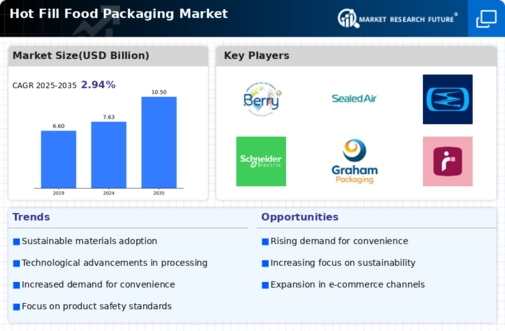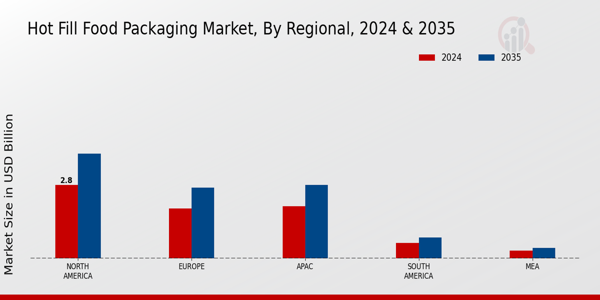Health and Wellness Trends
The growing awareness of health and wellness among consumers is influencing the Hot Fill Food Packaging Market. As individuals become more health-conscious, there is a rising demand for products that are perceived as healthier options. This trend is evident in the increasing popularity of organic and natural food products, which often utilize hot fill packaging to preserve freshness and nutritional content. Market analysis suggests that the health food segment is expected to grow by over 6% in the coming years, further driving the need for effective packaging solutions. Hot fill technology allows for the safe preservation of these products without the need for preservatives, thus appealing to health-oriented consumers. This alignment with health trends is likely to enhance the market's growth trajectory.
Regulatory Support for Food Safety
Regulatory frameworks aimed at enhancing food safety are playing a crucial role in shaping the Hot Fill Food Packaging Market. Governments worldwide are implementing stringent regulations to ensure that food products are safe for consumption, which includes guidelines on packaging materials and processes. This regulatory environment encourages manufacturers to adopt hot fill technology, as it is recognized for its ability to eliminate harmful microorganisms through high-temperature processing. Market data suggests that compliance with these regulations is becoming increasingly important, with a significant portion of the industry investing in technologies that meet safety standards. As a result, the Hot Fill Food Packaging Market is likely to benefit from this regulatory support, fostering growth and innovation.
Innovations in Packaging Technology
Technological advancements in packaging are significantly impacting the Hot Fill Food Packaging Market. Innovations such as improved barrier materials and enhanced sealing techniques are enabling manufacturers to create more efficient and sustainable packaging solutions. Recent data indicates that the market for advanced packaging technologies is expected to grow at a rate of 7% annually, reflecting the industry's commitment to innovation. These advancements not only improve product shelf life but also reduce waste, aligning with sustainability goals. As companies invest in research and development to enhance hot fill packaging capabilities, the overall efficiency and effectiveness of food preservation are likely to improve, thereby driving growth in the Hot Fill Food Packaging Market.
Rising Demand for Ready-to-Eat Meals
The increasing consumer preference for convenience foods is driving the Hot Fill Food Packaging Market. As lifestyles become busier, there is a notable shift towards ready-to-eat meals that require minimal preparation. This trend is reflected in market data, which indicates that the demand for packaged food products has surged, with a projected growth rate of approximately 5% annually. Hot fill packaging is particularly suited for these products, as it extends shelf life while maintaining flavor and nutritional value. Consequently, manufacturers are increasingly adopting hot fill technology to meet consumer expectations for quality and convenience. This shift not only enhances product appeal but also aligns with the broader trend of on-the-go consumption, thereby propelling the Hot Fill Food Packaging Market forward.
Sustainability and Eco-Friendly Packaging
The increasing emphasis on sustainability is a driving force in the Hot Fill Food Packaging Market. Consumers are becoming more environmentally conscious, leading to a demand for eco-friendly packaging solutions. This trend is reflected in Market Research Future, which indicates that the sustainable packaging segment is projected to grow by approximately 8% over the next few years. Hot fill packaging, often made from recyclable materials, aligns well with these sustainability goals. Manufacturers are exploring ways to reduce their carbon footprint and enhance the recyclability of their packaging solutions. As companies respond to consumer preferences for sustainable options, the Hot Fill Food Packaging Market is likely to experience significant growth, driven by the dual objectives of meeting consumer demand and adhering to environmental regulations.


















Leave a Comment